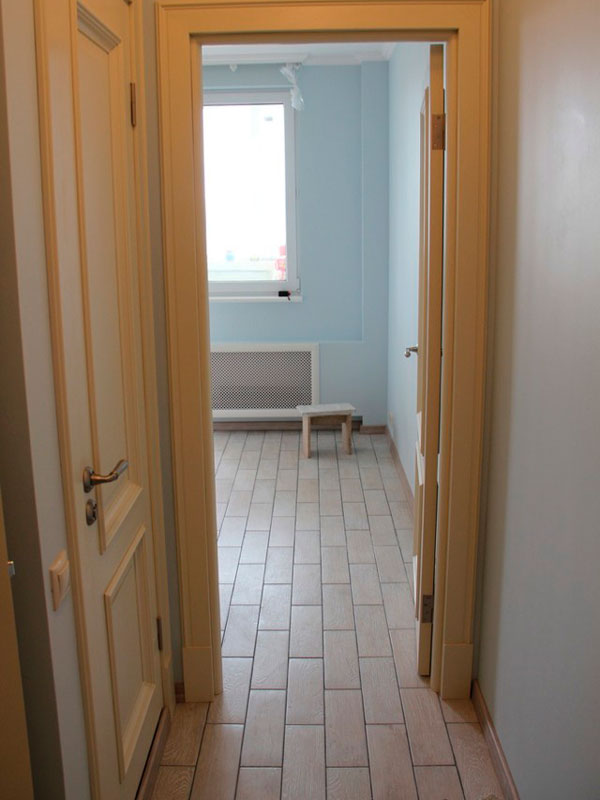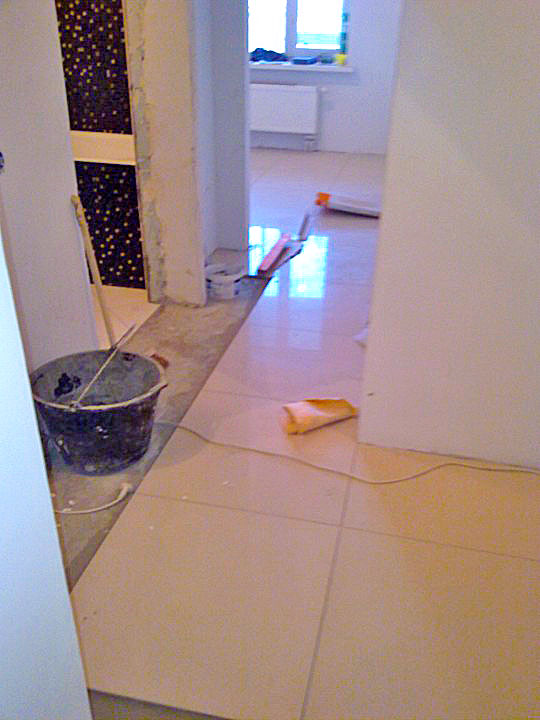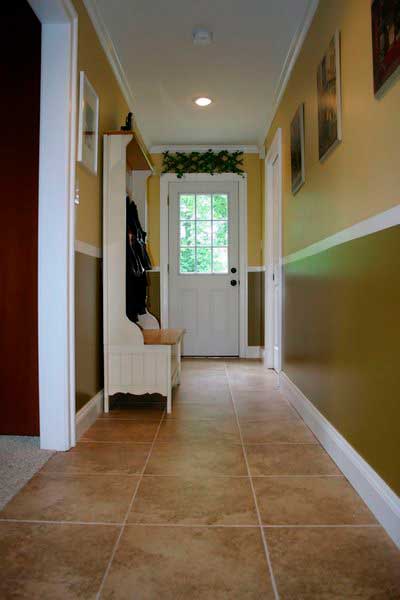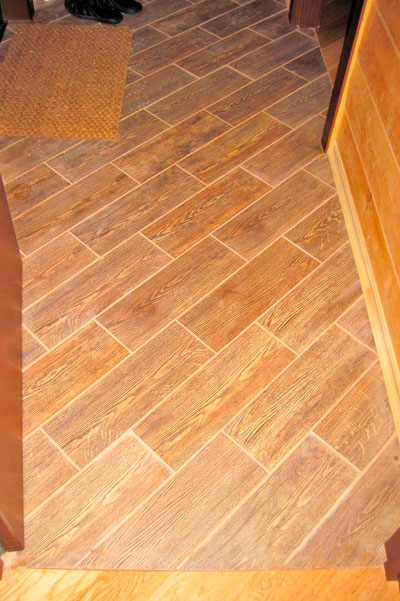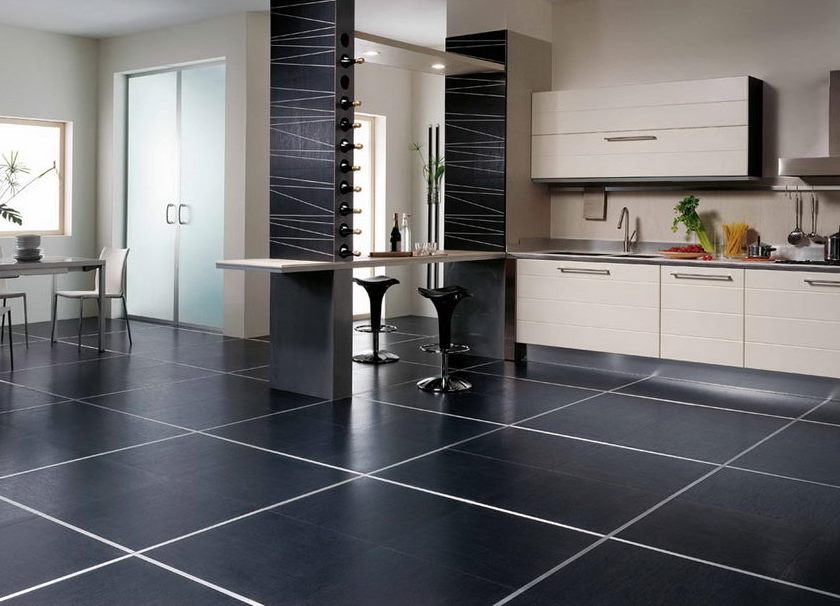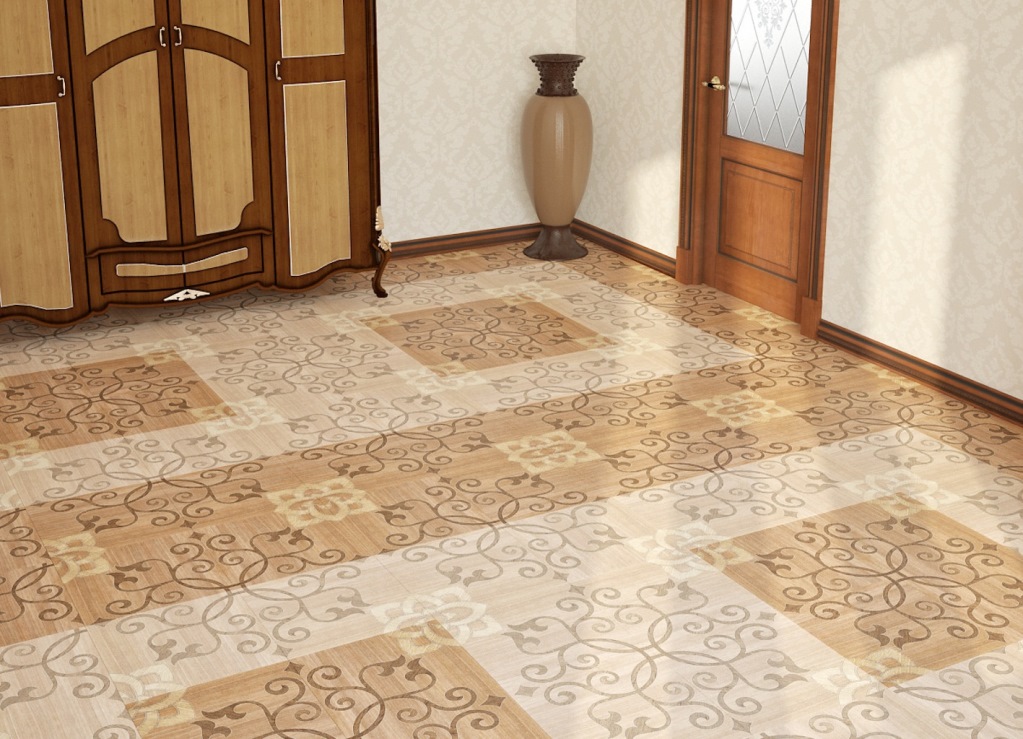Floor tiles in the corridor serve more than 10 years, easy to clean and. Unlike laminate it is not afraid of moisture from shoes, it looks more beautiful than linoleum. In this article we will consider the features of using tiles in the corridor.
Quick navigation for article
Floor heating
The main disadvantage of the tile is a cold surface. But the laminate is not warmer. This is easy to fix, but it is an additional cost to buy and use the system. If you like to walk along the corridor barefoot or you have small children, it is definitely worthwhile to install heating. Bonus you get dry shoes in the hallway.
Color and texture of the cladding
On a too dark or light surface, all the dirt is visible.
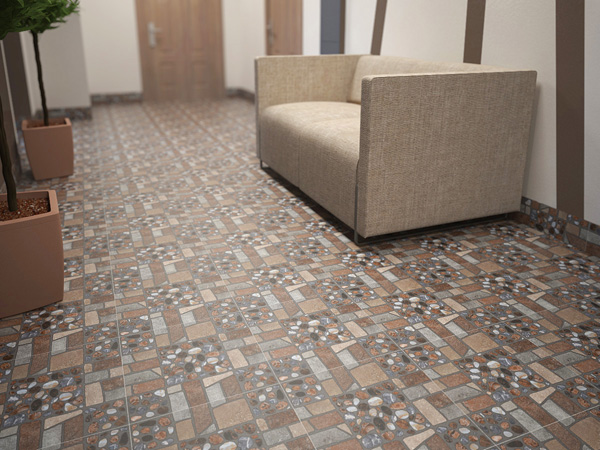
In order not to scrub the floor daily, it is better to choose some medium shade. Less dirt can be seen on a mottled, embossed surface.
For the floor in the corridor you need to choose a matt tile of dark color. It will not be slippery, the grime will not be visible for a long time. On a wet glossy tile it is easy to slip, and when the top layer of the enamel is rubbed, light bald spots appear.
Do not be afraid that the floor will look like at the station. Now there are many beautiful collections of porcelain stoneware for the floor in the corridor under the tree, natural stone. The tile floor is primarily a background for the interior. He does not have to be handsome, attract attention. It just needs to be comfortable and not spoil the look.

Italian porcelain stoneware Gambarelli, a collection of Latino Multicolor. Size 15 * 15 and a combination of colors make the cover not boring.
Layout
|
In the corridor there is a diagonal layout, in the kitchen there is a standard layout and another tile. The place of the joint looks ugly. |
|
In the best case floor tiles in the corridor and the kitchen should be laid with one "cloth" without transitions. The worst option is. You will constantly stumble over it, you will suffer with a pruning, dirt will be clogged there. 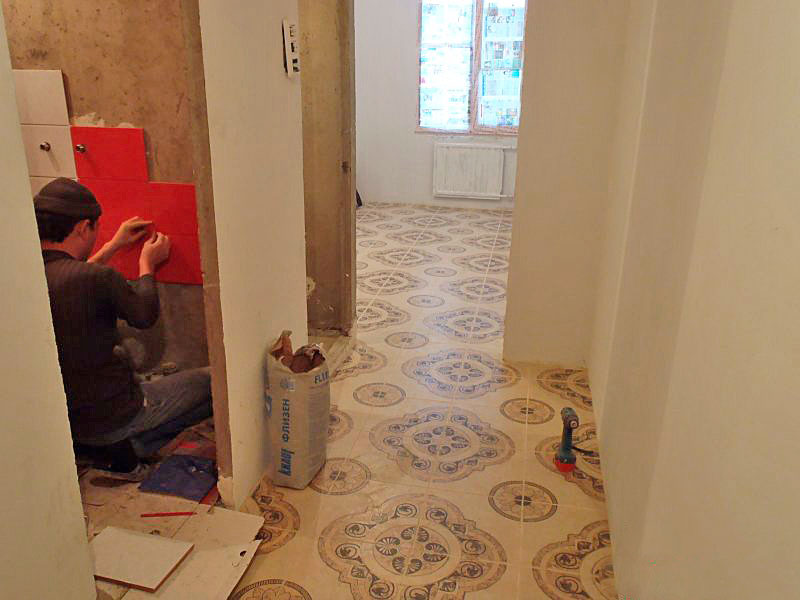

![]()
|
|
|
|
|
|

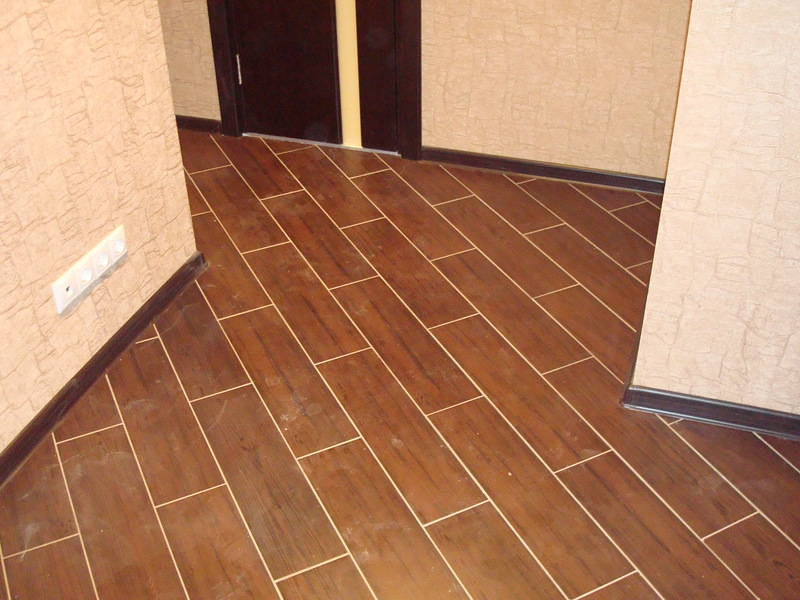

Russian tiles are cheaper, but they have a simple design, problems with geometry and dimensions. It is better to take Spanish, Portuguese, German and Italian tiles.
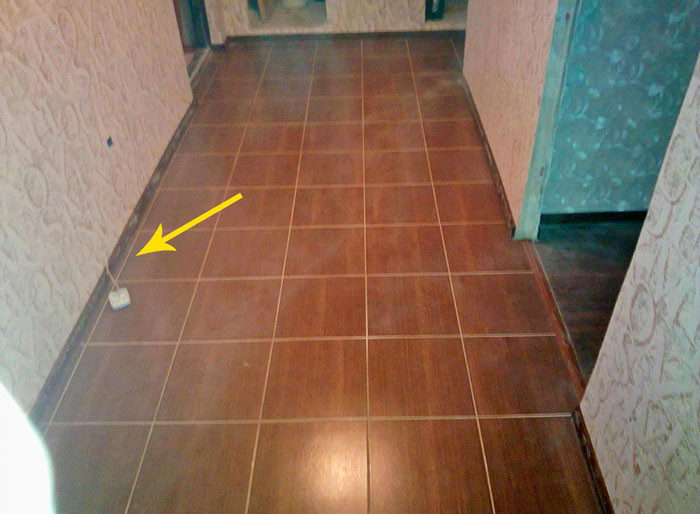
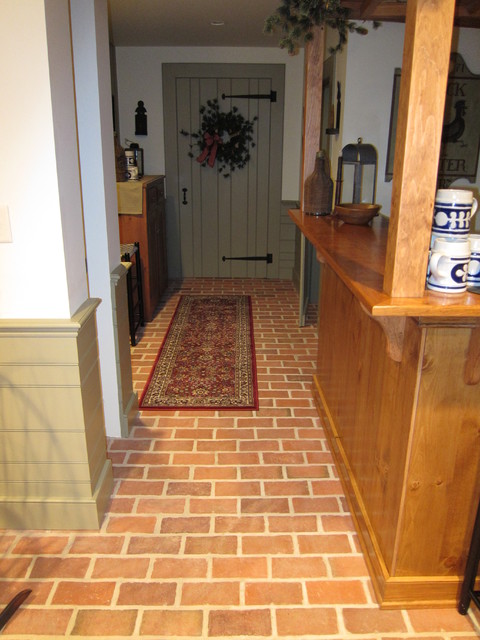
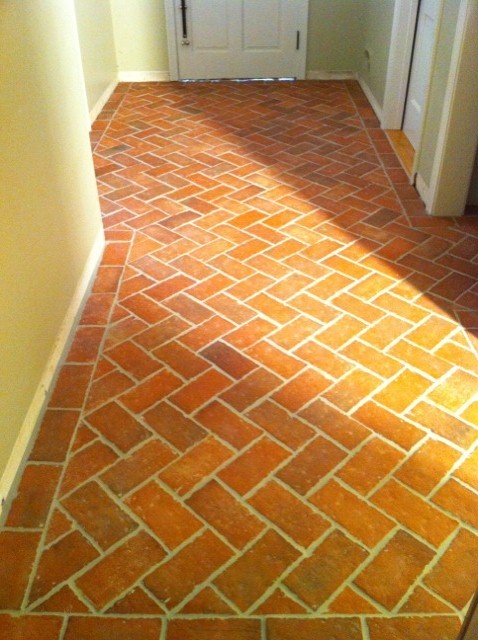
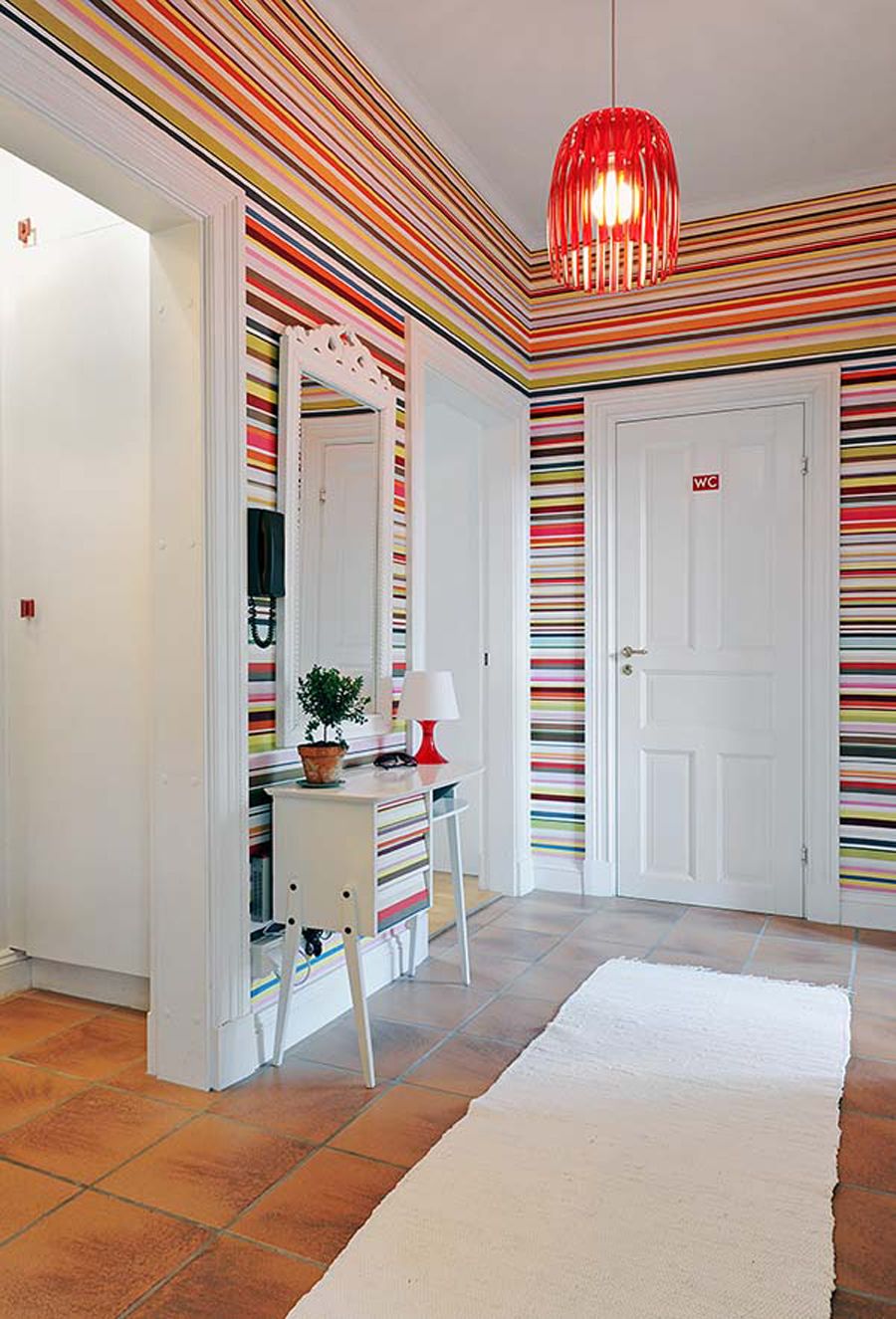
Wear resistance
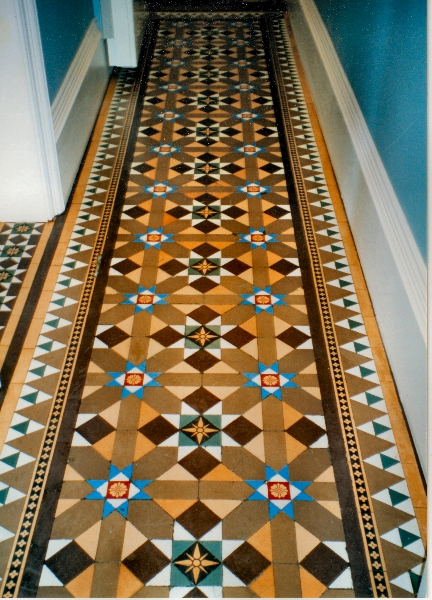
Tiles on the floor in the corridor should have 3, 4 or 5 class of wear resistance. The first and second class is not suitable for the corridor, as it marks the scratching of sand from the shoes. To reduce the impact of abrasives, at the entrance you need to lay a rug that will collect sand from the street.
Ceramic granite and ceramic tiles differ in the way they are made. The porcelain is obtained more durable and wear-resistant, so it is better suited for the hallway.
Similar to the characteristics of wear resistance with porcelain stoneware. From small details ceramic carpets with beautiful patterns are collected.
Color of seams
Although the tile itself is very simple to care for, seams remain vulnerable to the floor. If you fill them with a light trowel, the color will darken after a couple of months. Therefore, immediately choose a dark tile and grout, because they must be the same tone. The contrast stitches look ugly.
The light color of the seams on the floor can only be done when used. It is much stronger, permanently retains its color, but more expensive and more difficult to apply.

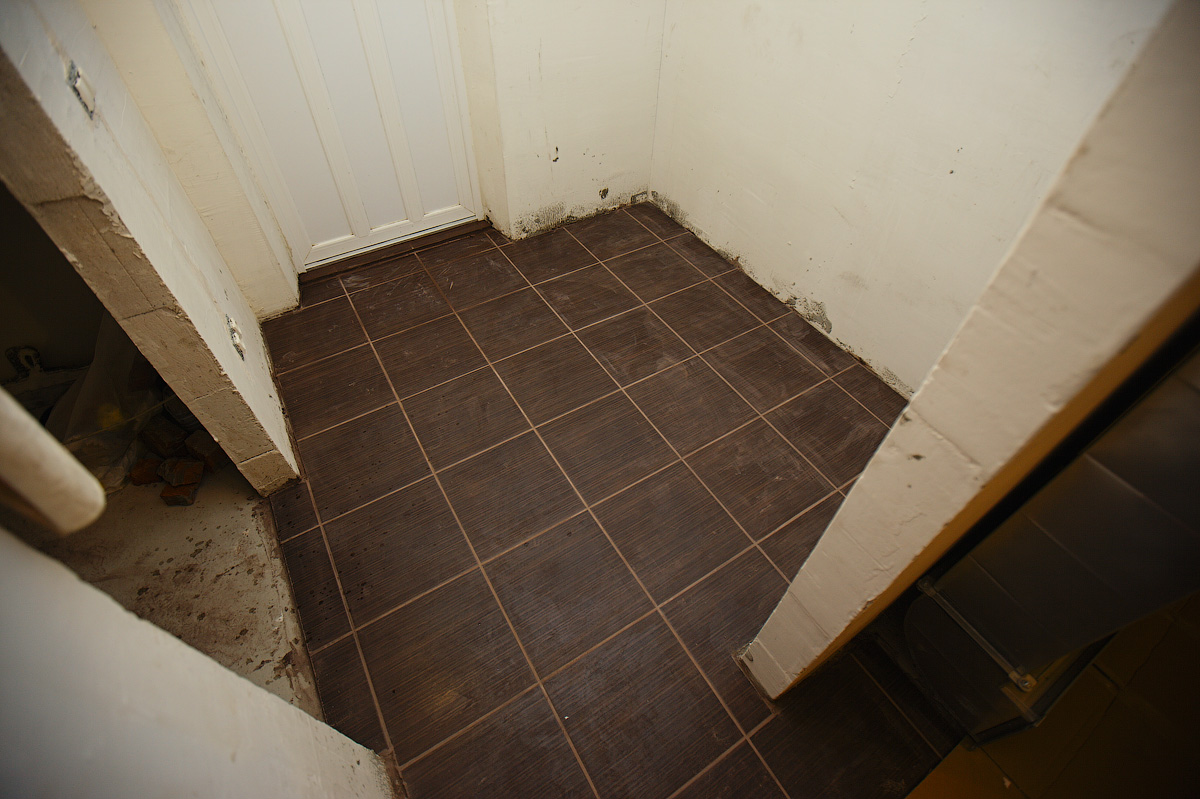
Tile Adhesive
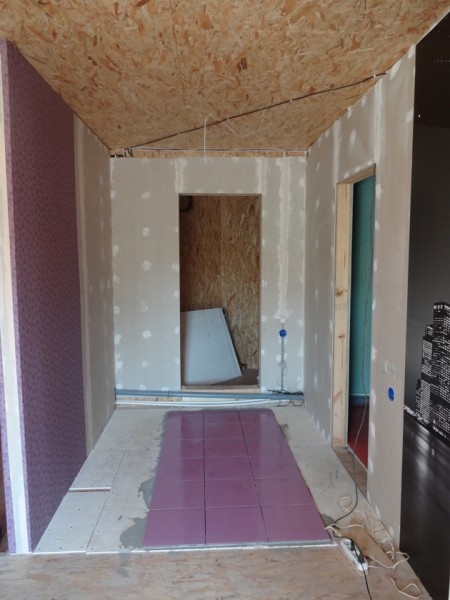
Laying on non-standard basis - glass-magnesium sheet (LSU).
When laying tiles in the corridor, do not spare money for good glue.
- If the conditions are standard (constant room temperature, cement base, tiles up to 45x45 cm), it is suitable, LITOFLEX K80 or a mixture of a similar class.
- When laying on non-standard substrates, you need to use a reactive (epoxy) adhesive, for example Litoelastic. Such mixtures are an order of magnitude higher, but stick "tightly". The tiles on the old tiles can be laid, but not for each mixture. For example, cement glue LITOFLOOR K66 is suitable for thick-layer laying. If possible, it is better to make a standard cement base.
- When laying on a warm floor, you need to take a highly elastic adhesive: Ceresit CM 17, KNAUF FLEX,.
- In private houses, the corridor can go straight to the cold vestibule or to the staircase. For their facing, frost-resistant glue is needed: Ceresit CM 17, CM 117, UNIS Granite.
In conclusion, I would like to remind you that the correctly prepared surface is no less important. The base should be smooth and stable, so that the laying is carried out on a minimum layer of glue. When facing a thick layer inevitably the appearance of voids under the tile, and this leads to their separation and the appearance of cracks.
comments powered by HyperCommentsThe flooring in the hallway constantly suffers from many factors: dirt and sand from the street, salt in the winter season, heels. Therefore, the coating should be different in quality and strength. But in addition to convenience and functionality, he needs to be beautiful, because the first thing that looks at the visitors is the floor. Therefore, tiles on - this is the best and durable choice of coverage.
Practical floor tiles in the corridor
The time when floor tiles were unattractive, long in the past. Modern material helps to realize the most original ideas in the hallway or corridor.
Pluses for the tile are plenty:
- Long service life. Such a floor covering will last for several decades, without losing the aesthetics of the species;
- The tile is durable and wear-resistant. High-quality ceramic tiles will withstand moisture, heavy loads of various shoes and detergents;
- The tile is hygienic. It will not cause allergies and is easy to clean;
- Decorative tiles have a large number of color solutions, and the types of styling options are huge;
- The tile adds status and aristocracy to the room. The corridor, which is faced with ceramic granite, looks luxurious.

But there are tiles and minuses, which should be taken into account before deciding to repair, because you need to change the interior with the mind.
Main disadvantages:
- Put ceramics in a huge hallway is not worth it, it will look too formal. It is better to combine tiles with other materials or choose warm colors;
- Glossy tiles with glaze can cause falls, especially if you go into the hallway in wet shoes. Having a family with children and elderly people, to acquire a tile is exclusively with a matte surface;
- The excessive depth of grooves and roughness of the tile can lead to its increased contamination. To avoid this, just before the door is to lay out a dark tile, and the rest of the square will be filled with light.
Quality tiles for kitchen and corridor floors should have certain indicators:
- PEI - index of tile strength. Its scale is up to 5 units;
- Indicator in percentage of moisture resistance of the coating;
- The size;
- Stability of the coating to chemical and other substances;
- Method of product production;
- Hardness of the coating. The ten-point scale of the MEP is the yardstick. The higher the number, the harder the tile will be;
- Grade. Red color indicates 1 grade of cover, blue - 2 varieties, green - 3. The price of a variety depends on how high it is.
When choosing a floor covering, do not take a tile with the best characteristics. Their price will be high, and tiles - almost the same, that in the middle, which is in the highest price category.
Floor tiles in the corridor of the hall: design and color choice
When choosing tiles, people are faced with a large assortment of goods. To determine which option should be stopped, it is necessary to listen to the advice of specialists.
Here are some of them:
- In the kitchen and the corridor should be taken cover with a rough top. Slipping will be lower, however, dirt can get into the groove. The glazed surface will withstand moisture better and will be stronger;
- When choosing the color of tiles you need to take into account the entire design of the room. Most often they take a light tile with a monochrome surface;
- The bright coating visually expands the space;
- Dark color tiles should be placed only in spacious hallways, while installing light furniture;
- Black and white tiles individually are a quick-foul variant, but the combination with such colors will never go out of fashion;
- The best colors for finishing these spaces are gray, brown, and also beige;
- On the matte surface, dirt is less noticeable;
- Tiles with the effect of natural stone will look incredibly stylish. A tile under a tree is considered universal;
One third of the collection of ceramics is Spanish tiles. In its design there are models with a pattern, classical motifs, etc. Has the highest quality class and stunning beauty that will fit into any bathroom, balcony or hallway.
If the corridor or hallway does not have windows, it is worth choosing a plain light tile. The darker the coating, the more light it will take.
Laying rules: tiles on the floor in the corridor (video)
All apartments are different: someone has a narrow corridor and a small hallway, others have huge rooms. In the issue of repair, it is necessary to take into account all the features and details of the dwelling so that its decoration leaves only pleasant impressions and does not cause quarrels and unnecessary expenditure of money. Wallpaper, tile, the layout of the free space, the placement of furniture - all these are components of the necessary coziness in the house.
The hallway is the most passable place in the house. Tiles on the floor in the corridor should be stable and of high quality, as it is subjected to intensive loads. In addition, a stylish tile visually decorates the interior, creates a first impression of a home, the room will look attractive and well-groomed for a long time.
Tile in the corridor - the pros and cons
The best for the hallway floor are materials that have increased strength characteristics, moisture resistance, are easily cleaned of contaminants. Ceramic tiles for the corridor - the most popular option of finishing. It has good performance characteristics, looks attractive and influences the visual perception of the room at the expense of different methods of styling and ceramics colors.
The positive aspects of this coating make him the undoubted leader of the finish. Its main advantages are:
- strength- tiles on the floor withstand significant mechanical impacts and shocks;
- wear resistance- the material safely transfers loads from heels, washing and cleaning abrasives;
- hygiene- ceramics are easy to clean, do not accumulate dust, are not susceptible to the appearance of mold and bacteria;
- moisture resistance- the material is not afraid of water, even flooding;
- durability- high-quality laid tiles will last at least half a century, without losing its original beauty;
- decorative appeal - a variety of styling options and color solutions allow you to create a different design of floors from tiles in the corridor;
- fire resistance- tiles do not burn;
- environmental friendliness- ceramics are safe for health;
- simplicity of restoration - In case of damage, it is possible to easily replace a separate section on the floor and not to change the whole coating.
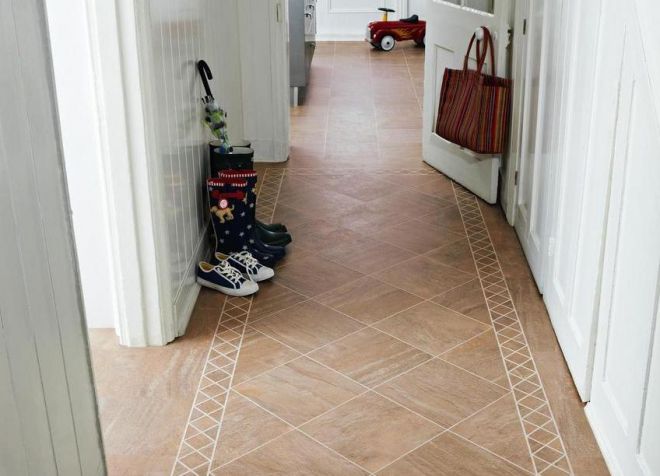
Having a lot of advantages, this facing has some disadvantages, which should be taken into account when choosing:
- hard and cold tiles - It is not very pleasant to walk on it barefoot. This disadvantage can be corrected by means of electric heating of floors. If the hallway has a large quadrature, you can tile the input fragment with a tile, combine it with other materials on the rest of the area;
- high slip coefficient - is noticeable when using a glazed surface. Therefore, tiles in the corridor of the apartment on the floor is selected with a matte, rough upper layer;
- if the ceramic has deep grooves and a light color, it quickly gets dirty, accumulates dust. Directly in front of the door is recommended to use a texture of dark color, and the main area of the room can already be decorated in light colors.
The use of tiles on the floor in the corridor offers many advantages. With a competent selection of material with its shortcomings it is easy to cope - use dark colors, matte textures in more transitory places. Finishing can be combined in different color combinations, create ornaments, patterns, combine with linoleum, laminate and create a beautiful interior.
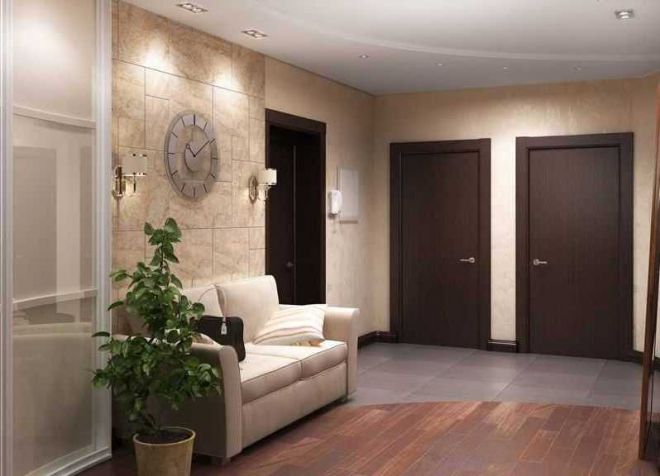
Tile in the corridor - design
At the heart of the ceramics is burned clay. It has a large stock to wear, long preserves the texture. The tile is made in various shades, decorated with inserts, patterns, decorative elements - borders, plinths. The coating is smooth or embossed, the design of the floors includes areas with different texture, interesting ways of laying are used. For example, the diagonal or transverse decoration of the corridor with tiles widens the narrow or long hallway. Light, dark shades of facing differently affect the visual perception of the room.
When decorating the hallway, tiles of different texture are used. Decorative tiles in the corridor fit on the floor in a room decorated in a classic or style. It can transmit the texture and characteristic pattern of quartzite, slate, granite, basalt. Marbling, agate or onyx has an attractive polished surface.
The tile under the stone is made in different shades - from white, light gray, sand to green, black with characteristic veins and impregnations. Often the material on the floor is made of, has a rough surface and is stronger than usual, in the entrance zone it looks natural. Surfaces can be decorated with beautiful panels, ornaments, rosettes, curbs from special decorative elements.
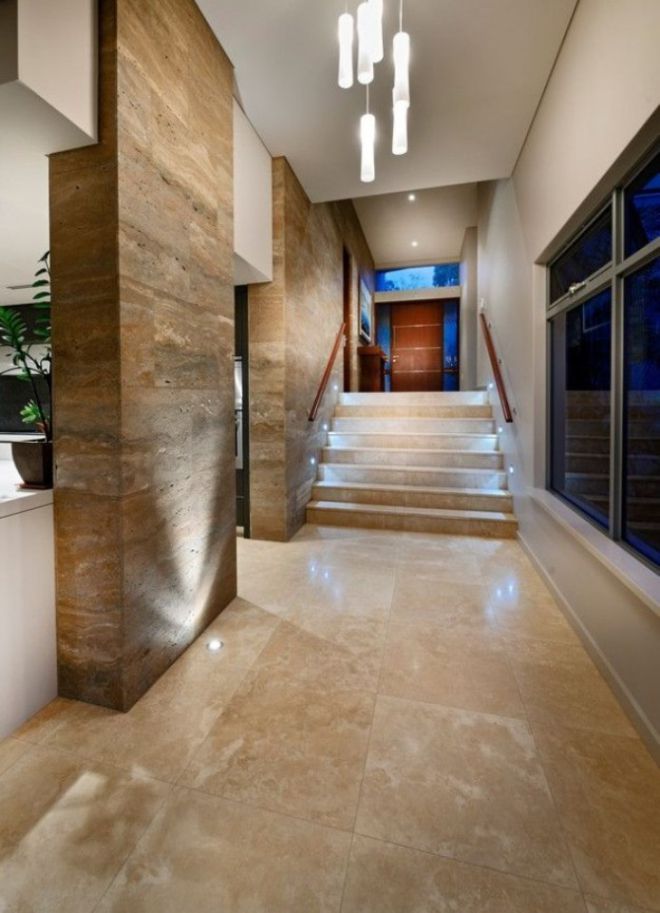
The warmth and comfort that brings wood to the house can be created with the help of a special tile. Different tile variants in the corridor under the tree can imitate patterns of pine, oak, beech, exotic wenge, rosewood. A special charm is the tile, which has an aged surface with scuffs and cracks. The material makes different formats - square, rectangular.
There are popular collections in which tiles on the floor in the corridor have the shape and size of a massive board, parquet slats. It creates the effect of an elite room, in which cleanliness and order are easily maintained. There are many design options, it is selected for the chosen interior of the hallway. It is actual to use a seamless surface, decorate it appropriately with drawings, curbs, tiles on the floor can be packed with a spanking, herringbone, "braid" with multi-colored inserts according to the type of parquet.
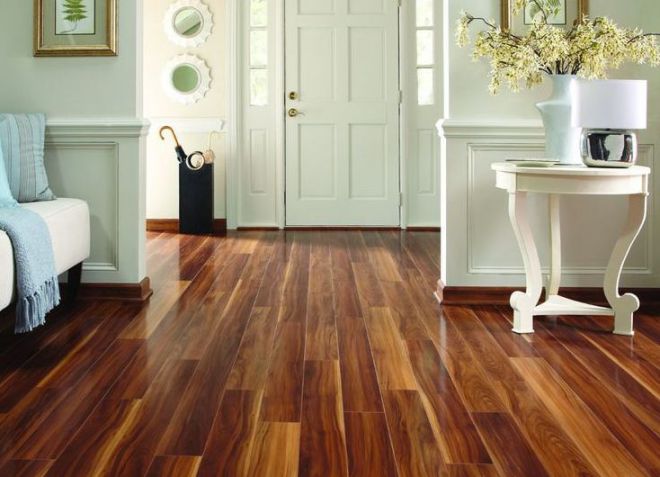
Mirror tile in the corridor
The hall area can be decorated with a reflective surface. Mirror and glossy tiles in the corridor create a multidimensional effect. It meets the traditional with a matte edge, tinted, can imitate expensive metals, decorated with ornaments with the help of sandblasting. Laying the material on the floor is done by squares or diamonds. Sometimes finishing some area of the surface along the edges, diagonally, interspersed with the pattern to create a beautiful decorative effect. Decorate the surface can be built-in illumination.
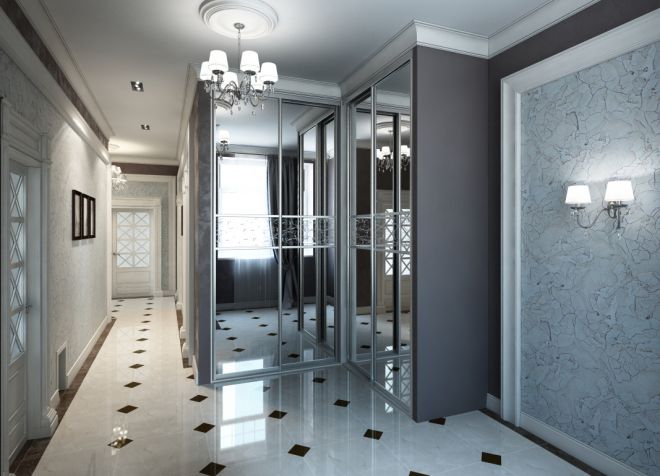
The dark material is practical and looks impressive. Black color is associated with luxury, austerity, minimalism. The surface of the tile is matte, glossy, polished, which creates different visual effects. In a small room, this shade is not recommended - it will reduce its volume. Dark tiles in the corridor on the floor can be combined with other deep colors, creating amazing effects. Popular black and white chess combination, blue, red, gold color, decorative elements will also help create beautiful ornaments on the surface.

Color is an effective tool for the designer. Gray tile on the floor gives the room a coldness, simplicity and restraint, is made of square, rectangular shape, of different sizes and texture - matte or glossy. The monochromatic surface looks laconically and strictly, often this decoration is diluted with ornaments and drawings. Gray tiles on the floor in the corridor often has an invoice under the stone, it looks natural, brings to the interior of monumentality. Silvery scale is well combined with white, emerald green, natural wood, mirror inserts.
There are many shades of gray. Light tiles in the corridor will be an excellent background for dark curbs and ornaments, juicy accents. A more saturated shade of tile in combination with white walls will look good. The classic version of the combination - gray and black, accents from the latter are created in furniture, framing, glossy inserts, ornaments laying.

This is a classic shade, it fits seamlessly into any interior. White color is able to visually increase the space, so this tile in a narrow corridor is more appropriate. In addition, it causes a sense of calmness, comfort and cleanliness, is an excellent background for furniture, contrast inserts, on such a surface you can lay out a beautiful pattern of colored material. Beautifully looks tile with impregnations from other shades, for example, marble with veins. From ceramics of different sizes and colors, attractive geometric patterns and rosettes are laid out.

Natural shades are relevant for modern interiors. Beige color of tiles in the corridor is a practical option, it is easy to keep clean. The material is well combined with wooden furniture and classic design, with the decoration of the walls for wood, stone, plaster. The form of beige tiles on the floor in the corridor is made equilateral or elongated, it can imitate wooden boards, parquet. With the help of brown inserts on the floor it is easy to create patterns, borders. Various methods of laying are applied - squares, vzrazbezhku, with a combination of material of different sizes.
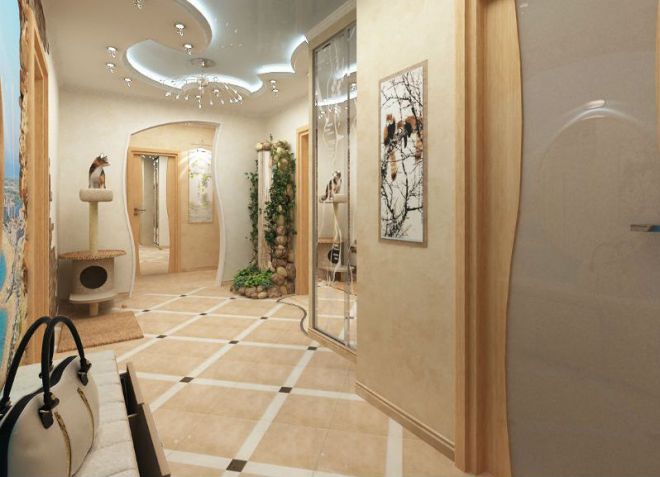
This color looks expensive and neutral. If it is necessary to emphasize the nobility of finishing and natural wood furnishings, brown tiles in the corridor are used, the interior with it looks respectable. It is made in three variants - under a stone, a tree, monophonic. Monochrome texture looks better with decorative elements - curbs, drawings, accent inserts. The material under the tree brings comfort and warmth into the room, the stone texture creates a feeling of freshness and massiveness. The best companions for brown are beige, cream colored.
Tiles on the floor in the corridor - a good and practical solution. Cold air, high humidity, hard soles of shoes, heels, street dirt and dust are an incomplete list of negative phenomena that she will face every day. Such a practical and durable material will ensure the reliability of the coating for a long time. In addition, the tile is aesthetically attractive, the great choice of colors and textures of the material makes it possible to create an interesting design in the hallway, which will be the first to meet guests and hosts.

Tile, has become a modern and practical solution for the floor in the hallway. The flooring in this room should be resistant to mechanical damage and chemical agents. It is in the corridor that the floor is considered the most problematic, since it is the only surface that faces a lot of dirt and damages from heels and transport attributes. At the moment, you can forget about the unattractive appearance of the tile. Design solutions for tiles can allow you to make all your dreams come true.
Tile in the corridor: advantages and disadvantages
Thanks to the new tile designs, you can completely improve the look of the corridor. A variety of colors, textures and pricing policy will help to organize any design decision. Using the tile, you can expand, extend the room or focus on a certain area. Texture can copy a variety of materials, for example, fabric, stone or wood. In terms of the embodiment of fantasies and ideas, there is nothing better than tile. It remains only to select the necessary tile for the floor.
The positive side of the tile is its strength and stability, it can not be compared to either a laminate or a parquet.
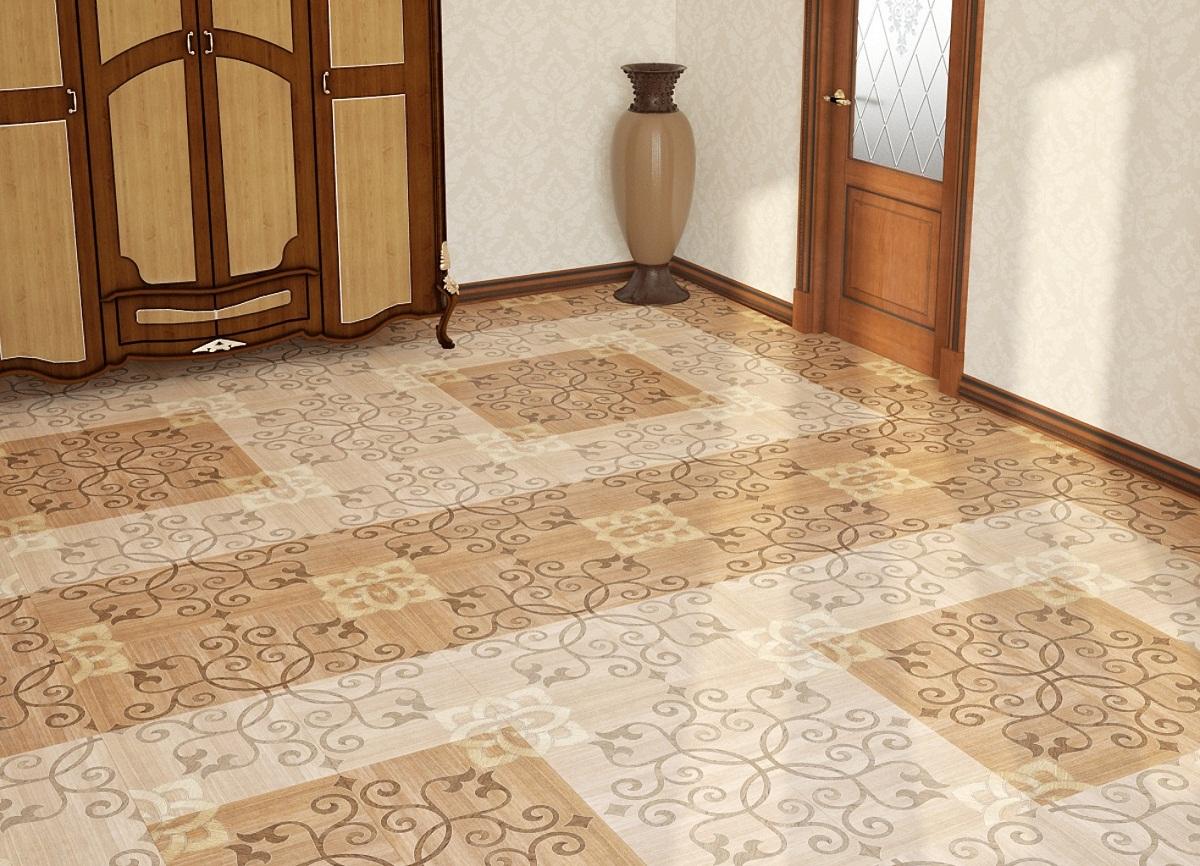
You can not argue with the fact that the tile is well in use, it is easy to wash, and the hall becomes clean and neat. Absolutely no matter which tile will lie on the floor, it will in any case create an effect of expensive material. In addition to all of the above, the tile can retain its look and look presentable for many years.
The main disadvantage of the tile is that it is cold and you can lose the feeling of comfort. In addition, picking up the wrong design can create a boring interior.
- Under the tile you can install a system of warm floor;
- If the hall is large it can be zoned. An excellent option will be to cover the part at the entrance door;
- To give preference to tiles with the image of a tree, this will create a cozy atmosphere.
Which floor tile in the corridor is better
Before you make a choice: tile or ceramic tiles, you need to thoroughly familiarize yourself with the technical specifications.
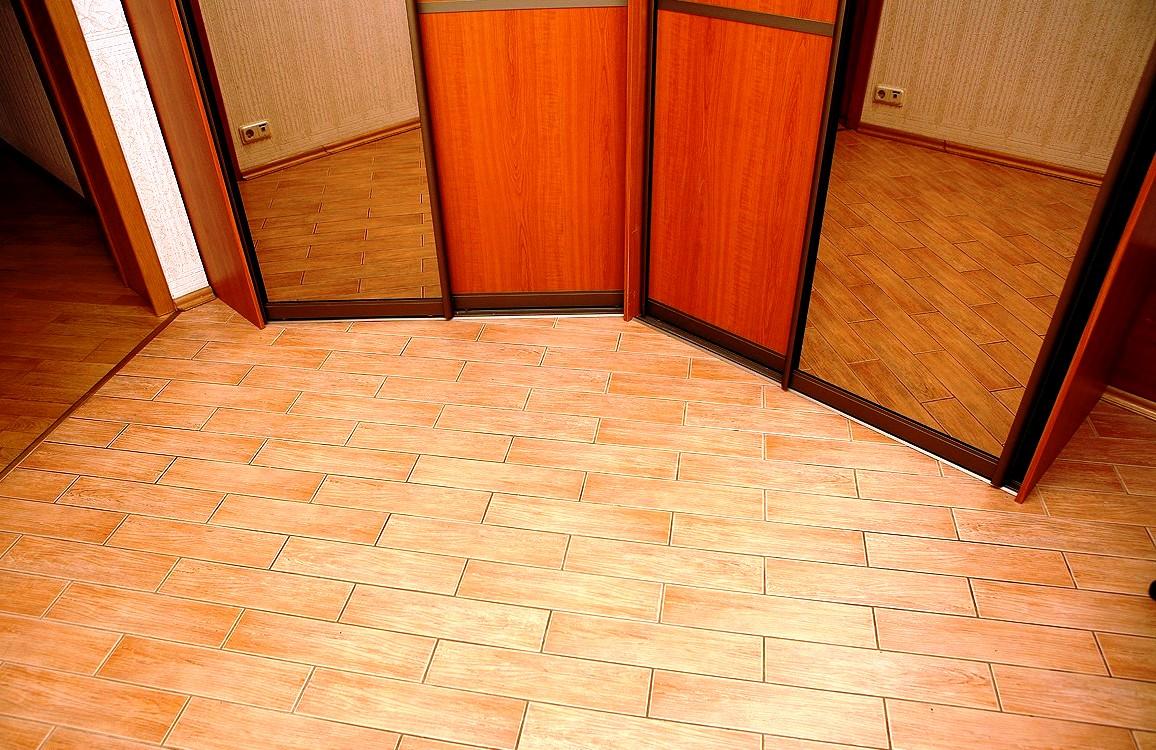
Good tiles have these qualities:
- Resistant to erasure and shock. Since the load in the hallway is higher than in the other rooms, and this negatively affects the coverage. When choosing, pay attention to such indicators as REI 4 and REI 5, they are a mark of high quality;
- Since the floor in the corridor is a collection of dust, and dirt it will often be washed with chemical means. To find out which tile is more resistant to powders, gels and other chemicals, you should pay attention to the AA index. Such ceramics are as resistant to abrasive agents as possible. In addition to this indicator, it is possible to cover the floor with tiles marked A and B;
- Water resistance should not exceed 3%. It is achieved in the process of roasting, and when choosing a certain product, pay attention to the chip material, it must have a bard color and a smooth surface;
- For tiles in the corridor, it is very important to make a choice in favor of an anti-slip surface. For this room, the indicators R10 and R11 are suitable, and the friction index should not be below 0.75. In addition, the coating must be rough and embossed.
Based on the above tips, experts recommend not to stop on glossy surfaces, since getting liquid on their surface can be fraught with injuries. In addition, after a certain time, the appearance becomes dull and will acquire an ugly appearance.
Dimensions of floor tiles in the corridor: the value of the dimensions
The question of the size of the tile is very relevant.
Laying tiles in small sizes, you can not only create a cozy atmosphere, but also save on the material, as it does not need to be cut often.
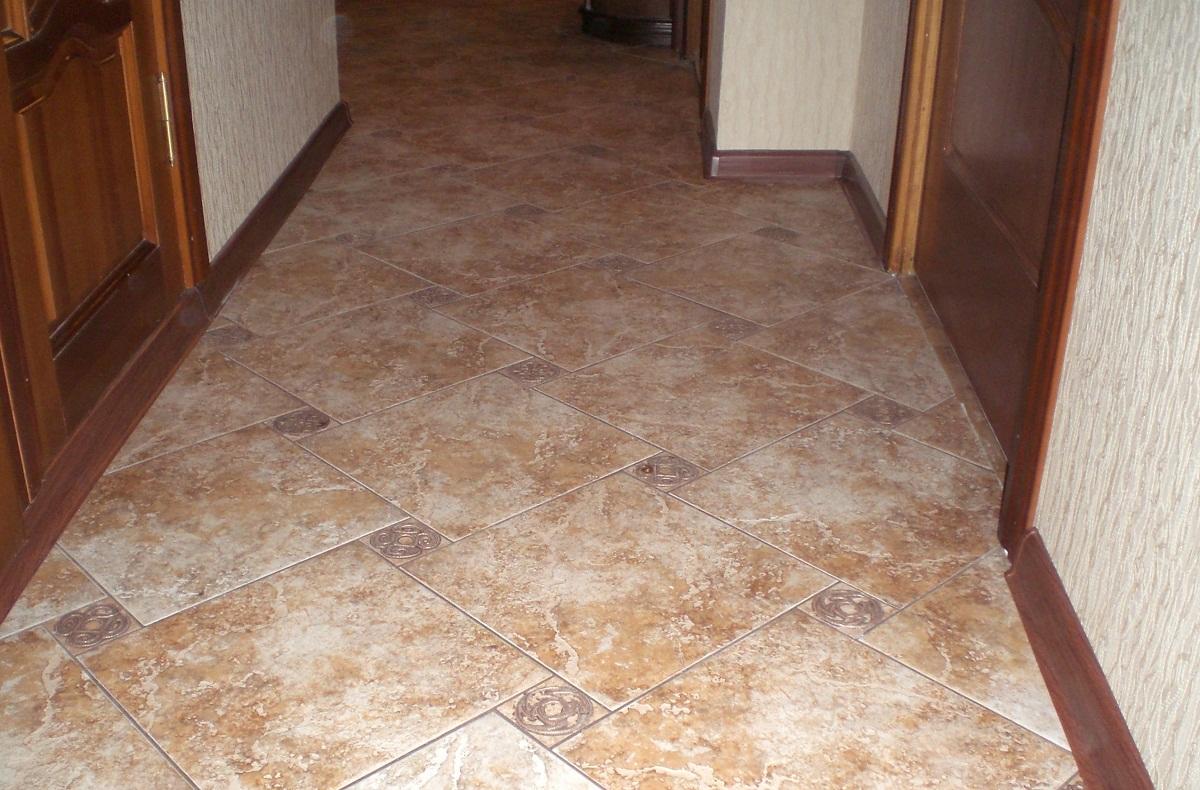
As for tiles of large sizes, it can help significantly save time and effort, as it fits much faster and easier. In addition, it practically does not get moisture and debris, due to the fact that it has a minimum number of seams. However, its gaps quickly lose their aesthetics, and the tile loses its attractive appearance.
The choice of tile dimensions depends on the size of the hallway. So in a small corridor you should not choose a large tile, it is better to stop on small forms. Such a tile will help to hide the oblong room. If the corridor is large, then you can show imagination and tile, almost like the size, it will look beautiful large sizes made of ceramics.
Color tiles on the floor for the corridor
Specialists in the field of design highlight a number of features on which to determine the color of the future tiles.
For example:
- Do not use too light colors. Light tiles are impractical, especially if there is a relief texture. Such a design contributes to the rapid accumulation of dust;
- On a dark, albeit not too saturated shade, scratches and chips will be noticeable. In addition, black tiles display a lot of dirt;
- Solving the problem with a hint, find a compromise. For each room comes its own coloring, as well as design by drawing. Cold colors can make the entrance hall spacious and cozy, while the dark ones will visually make the space smaller, of course if necessary;
- The color of the tiles is best selected in accordance with the coloring of the remaining rooms, so you can select certain zones;
- Do not create excessive brightness, this will reduce the size of the room.
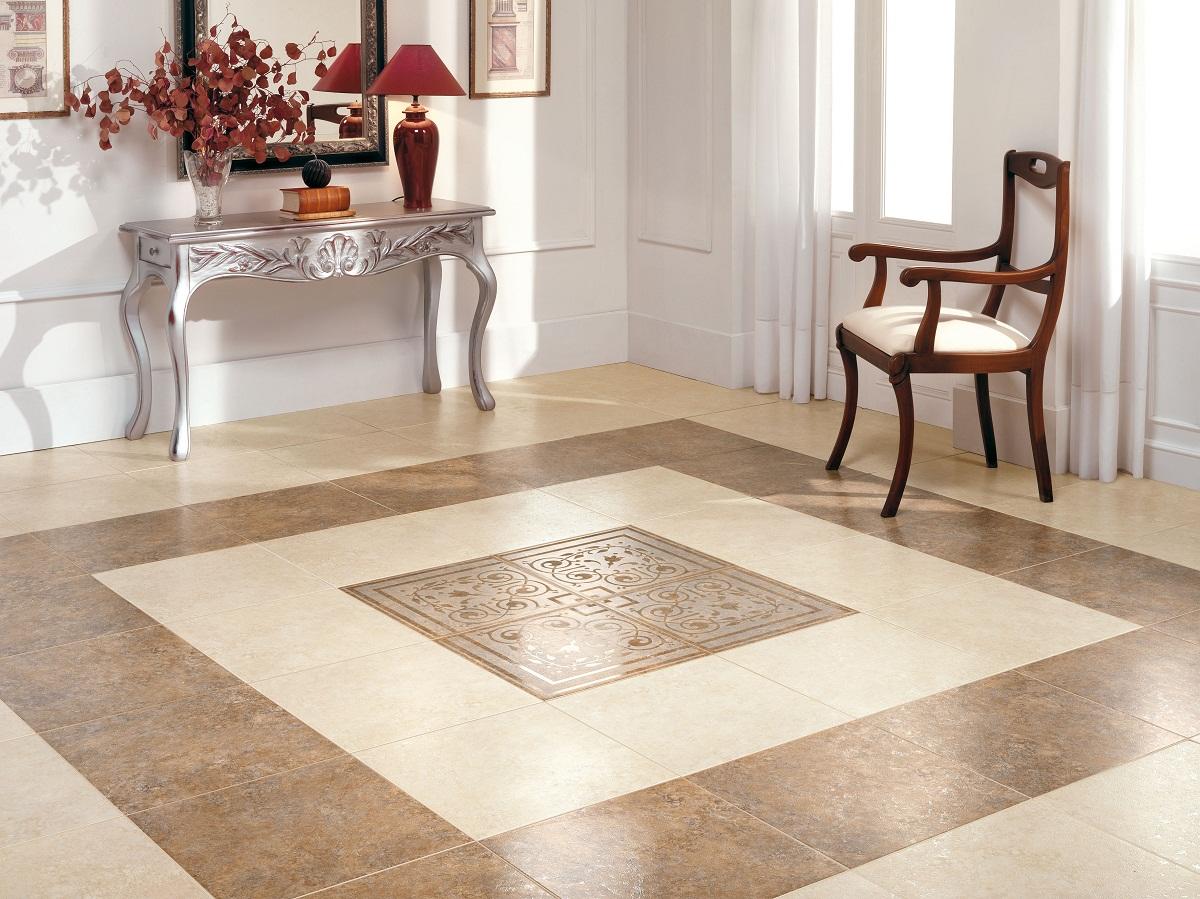
Of course, what kind of tile to stack, is the choice of the owner, but we should not forget that the tile pattern should ideally be combined with the design of the hallway walls.
How to lay out the tiles in the corridor and bathroom
Laying tiles is an important working moment, so before you put the tile in the bathroom or hallway you need to think about exactly which way the owner will use it.
Species can be:
- Standard packing or rowing. If the tiles are the same, then this option is suitable. It is often used for kitchens and laying on a narrow balcony. Also, this method is ideal for large ceramics;
- Brick method. To put a tile in this way follows in the event that the tile has a rectangular shape, but for a bathroom such layout will not work, in that case if it is small-sized;
- Parquet laying. Used for ceramics, decorated for a tree;
- Modular installation. It is selected if it is necessary to create a certain pattern from different colors and shapes of tiles. As a rule, such installation is difficult and requires a lot of effort;
- Laying diagonally. Used in the event that the walls have a defect and it needs to be hidden. This layout is ideal for hallways and bathtubs of irregular shapes. The laying specialist must possess certain skills in order to achieve the desired result.

Do you want to achieve a detrimental effect? Use a tile of two colors and set it in staggered order. This design is perfect for both the bathroom and the hallway.
Tile and corridor apartments: fresh ideas
In order to create an ideal room, use zoning. An excellent option will be the allocation of a separate angle for shoes, it can be laid out with tiles more elegantly. Do not follow the stereotypes, stop on stylized options, dilute the decor with mosaic. It looks great combination of tiles and laminate. This option will never be lost and will meet all the requirements of aesthetics.
Determined with the choice of tiles, do not forget about the ceramic frieze. Choose plastic skirting is not worth it, because it will look not only cheap, but also tasteless.

As for the choice of color, it depends on the cavity because the wallpaper, ceiling and furniture look like. In addition to these points, you need to pay attention to the overall design of the corridor. If the design of the hallway is sustained in a strict style, marble tiles are suitable, but if it is an oriental style, the ornate ornament will perfectly fit. Other styles can be made in checkerboard order.
Beautiful tiles on the floor in the corridor (video)
Repairing a house is always a troublesome business. The hallway is the room that is seen first at the entrance to the house. In the case of tile selection, it is not necessary to dwell on evaluating its technical parameters, such as durability, strength or slip resistance. No less important feature is their aesthetic side. You should not choose tiles yourself, it's best to ask advice from experts or friends, view photos of examples. Finishing and types can be completely different. It can be Spanish tiles or other decorative, each kind should be in its own way lined. It is necessary to take into account different opinions in order to have their own and correct.
Choosing a flooring in the hallway, we first think about its durability and reliability. The floor tile in the corridor meets all the requirements for the flooring material, namely
so its popularity is growing every year.
Today, manufacturers offer a huge selection of tiles in the hall, a wide range includes products from different materials and textures, the price also ranges from minimal to fabulously high. Thanks to this choice, anyone can buy a suitable option that meets all of its requirements.
The advantages of ceramic tiles
Ceramics is one of the most reliable finishing materials. Its advantages as a floor covering for the hallway can be listed for a long time, we will focus only on the most basic:
- Durability
Laying tiles in the corridor is a reasonable solution that will protect you from repairing in this room for at least 10-15 years. The service life of the tile is several decades, it is resistant to mechanical impact and chemical agents.
- Universality and environmental friendliness
Ceramics can be used to finish the floor and walls, it will perfectly complement the interior of the bath, kitchen, living room or hallway. Tile as a finishing material is absolutely harmless to human health.

- Huge variety
The modern choice of shapes, sizes, colors, ornaments and textures amazes imagination. A good taste will allow you to make floor tiles in the corridor with the highlight of the entire interior.
- Ease of installation
To lay the tile on the floor, you do not need to have special skills, with due skill and care almost any person can do it.
- Ease in washing
Tile is the ideal material for flooring in the hallway in terms of washing. It is easy to clean, in addition, he is not afraid of virtually no chemical.

Criteria for selecting tiles
Buying a tile on the floor in the corridor is a serious task, since it is in this room that a high degree of load is put on the flooring. Let's figure out how to choose a quality tile that meets all the requirements.
Strength
Strength and durability are among the main criteria when buying. The floor in the corridor must withstand the load of heels, weights, dirt and reagents from the street.
On the strength scale, tiles are divided into five classes. As a floor covering in the corridor, choose a ceramic tile of 3,4 or 5 class.
Remember: the larger the number, the higher the strength of the tiles.
Moisture resistance and resistance to chemicals
Ceramic tiles have a low porosity - this provides a fairly low level of moisture absorption. When selecting tiles on the floor in the corridor, pay attention to this detail. The level of moisture absorption should not exceed 4-6%.
We wash my floors in the corridor quite often, and in autumn and winter almost daily. Therefore, choose a tile with a class of maximum chemical stability - or A, or AA.
Hardness and coefficient of friction
The level of hardness in the whole world is measured on the Mohs scale. For finishing the hallway, buy a tile with an indicator of at least 6-7 points.
That you and your loved ones do not slip on a perfectly smooth floor, and walk in the hallway was comfortable and safe, you need to pay attention to the coefficient of friction. It must be at least 0.7. It's great if your tile has a special anti-slip coating.
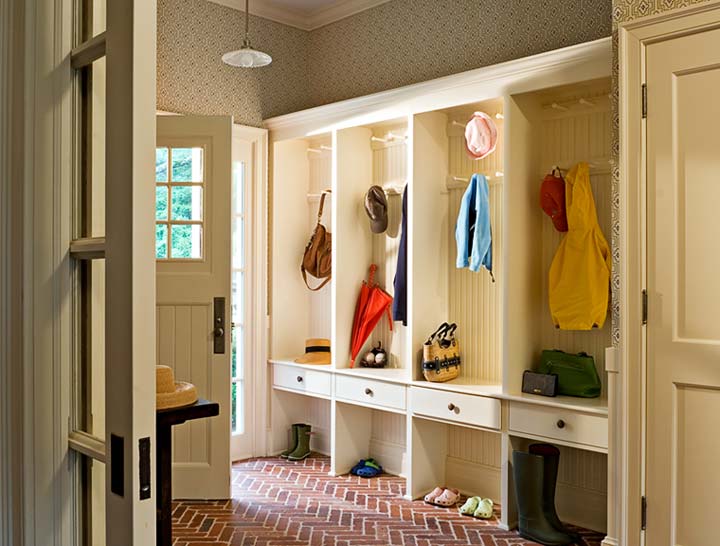
Design
Whatever one may say, choose a tile in the hallway, usually by design and photo. It is the floor covering that often sets the tone and mood for the whole interior.
It is best to give preference to the dark or medium tone of the tile, because the light floor will be contaminated catastrophically quickly. On an absolutely black ceramic surface, any damage and dust will be very noticeable.
Remember that a large light tile on the floor in the corridor can make the room visually wider, and also covers cold shades. Dark and shallow tiles will create a sense of narrow and close corridor, this means that with such material one must be extremely cautious.
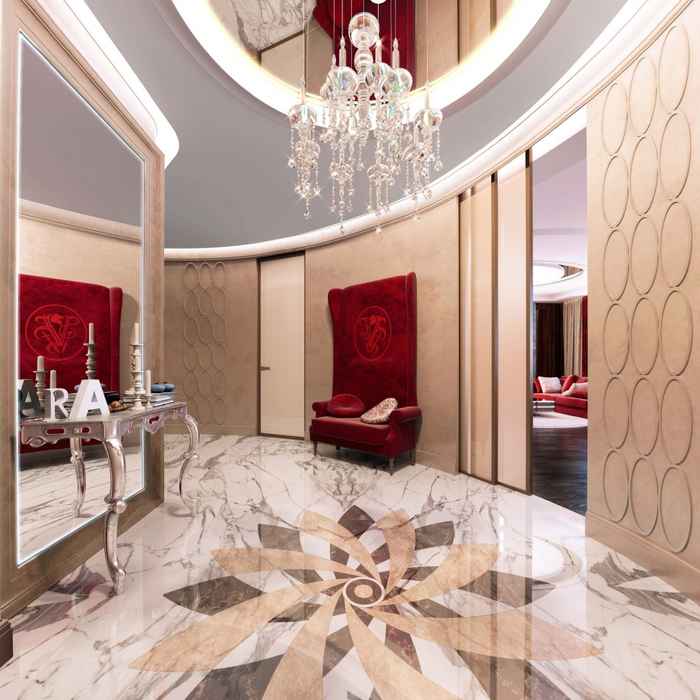
Conclusion
To finish the floor in a renovated hallway, you can use a variety of finishing materials, based on your preferences and financial capabilities. But tiles are, without a doubt, one of the most preferred flooring options. A large selection of products will allow you to purchase exactly the materials that will suit you for price, quality and design.
2015-11-13

